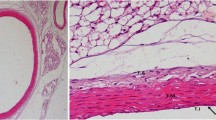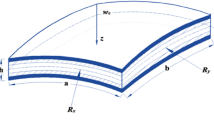Abstract
The present study aims at investigating biomechanical failure behaviour of human aneurismal aortic tissues so as to diagnose the rupture risk of aneurysms more accurately. An inflation test is performed on aneurismal aortic tissues up to failure and full-field measurements are achieved using stereo digital image correlation. Then, an appropriate constitutive model derived from histological structure of arteries is adopted to retrieve the Cauchy stress. The virtual fields method is used as an inverse procedure to identify material parameters. Next, the Cauchy stress components are calculated from the identified parameters and the measured Lagrange strain fields. Finally, an important stress parameter which can quantify the strength of aneurismal tissues is derived from the failure stress of aneurismal tissues.
Similar content being viewed by others
References
Avril S, Grédiac M, Pierron F (2004) Sensitivity of the virtual fields method to noisy data. Comput Mech 34(6): 439–452
Avril S, Badel P, Duprey A (2010) Anisotropic and hyperelastic identification of in vitro human arteries from full-field measurements. J Biomech 43(15): 2978–2985
Brunon A, Bruyère-Garnier K, Coret M (2011) Characterization of the nonlinear behaviour and the failure of human liver capsule through inflation tests. J Mech Behav Biomed (article in press)
Carew T, Vaishnav R, Patel D (1968) Compressibility of the arterial wall. Circ Res 23(1): 61–68
Choksy S, Wilmink A, Quick C (1999) Ruptured abdominal aortic aneurysm in the Huntingdon district: a 10-year experience. Ann R Coll Surg Engl 81(1): 27–31
Coady M, Rizzo J, Hammond G, Mandapati D, Darr U, Kopf G, Elefteriades J (1997) What is the appropriate size criterion for resection of thoracic aortic aneurysms. J Thorac Cardiovasc Surg 113(3): 476–491
Darling R, Messina C, Brewster D, Ottinger L (1977) Autopsy study of unoperated abdominal aortic aneurysms. Circulation 56(3): 161–164
Dobrin P (1989) Pathophysiology and pathogenesis of aortic aneurysms. Surg Clin North Am 69(4): 687–703
Doyle B, Cloonan A, Walsh M, Vorp D, McGloughlin T (2010) Identification of rupture locations in patient-specific abdominal aortic aneurysms using experimental and computational techniques. J Biomech 43(7): 1408–1416
Fillinger M, Raghavan M, Marra S, Cronenwett J, Kennedy F (2002) In vivo analysis of mechanical wall stress and abdominal aortic aneurysm rupture risk. J Vasc Surg 36(3): 589–597
Fung Y (1993) Biomechanics: mechanical properties of living tissues. Springer, New York
Gasser T, Ogden R, Holzapfel G (2006) Hyperelastic modelling of arterial layers with distributed collagen fibre orientations. J R Soc Interface 3(6): 15–35
Grédiac M, Toussaint E, Pierron F (2002) Special virtual fields for the direct determination of material parameters with the virtual fields method. 1-principle and definition. Int J Solids Struct 39(10): 2691–2705
Grédiac M, Pierron F, Avril S, Toussaint E (2006) The virtual fields method for extracting constitutive parameters from full-field measurements: a review. Strain 42(4): 233–253
He C, Roach M (1994) The composition and mechanical properties of abdominal aortic aneurysms. J Vasc Surg 20(1): 6–13
Holzapfel G, Gasser T, Ogden R (2000) A new constitutive framework for arterial wall mechanics and a comparative study of material models. J Elast 61(1-3): 1–48
Holzapfel G, Sommer G, Gasser C, Regitnig P (2005) Determination of layer-specific mechanical properties of human coronary arteries with non-atherosclerotic intimal thickening, and related constitutive modeling. Am J Physiol Heart Circ Physiol 289(5): H2048–H2058
Hsu F, Liu A, Down J, Rigamonti D, Humphrey J (1995) A triplane video-based experimental system for studying axisymmetrically inflated biomembranes. IEEE T Bio-Med Eng 42(5): 442–450
Humphrey J (2002) Cardiovascular solid mechanics. Springer, New York
Luo P, Chao Y, Sutton M, Peters W (1993) Accurate measurement of three dimensional deformations in deformable and rigid bodies using computer vision. Exp Mech 33(2): 123–132
Marra S, Kennedy F, Kinkaid J, Fillinger M (2006) Elastic and rupture properties of porcine aortic tissue measured using inflation testing. Cardiovasc Eng 6(4): 123–131
Mohan D, Melvin J (1983) Failure properties of passive human aortic tissue. II-biaxial tension tests. J Biomech 16(1): 31–44
Nicholls S, Gardner J, Meissner M, Johansen H (1998) Rupture in small abdominal aortic aneurysms. J Vasc Surg 28(5): 884–888
Ogden R (1997) Non-linear elastic deformations. Dover Publication, New York
Rodríguez J, Ruiz C, Doblaré M, Holzapfel G (2008) Mechanical stresses in abdominal aortic aneurysms: influence of diameter, asymmetry, and material anisotropy. J Biomech Eng 130(2): 021,023
Seshaiyer P, Hsu F, Shah A, Kyriacou S, Humphrey J (2001) Multiaxial mechanical behavior of human saccular aneurysms. Comput Method Biomec 4(3): 281–289
Sommer G, Gasser T, Regitnig P, Auer M, Holzapfel G (2008) Dissection properties of the human aortic media: an experimental study. J Biomech Eng 130(2): 021,007
Sumner D, Hokanson D, Strandness D (1970) Stress-strain characteristics and collagen-elastin content of abdominal aortic aneurysms. Surg Gynecol Obstet 130(3): 459–466
Sutton M, Yan J, Tiwari V, Schreier H, Orteu J (2008) The effect of out-of-plane motion on 2d and 3d digital image correlation measurements. Opt Laser Eng 46(10): 746–757
Venkatasubramaniam A, Fagan M, Mehta T, Mylankal K, Ray B, Kuhan G, Chetter I, McCollum P (2004) A comparative study of aortic wall stress using finite element analysis for ruptured and non-ruptured abdominal aortic aneurysms. Eur J Vasc Endovasc Surg 28(2): 168–176
Vorp D (2007) Biomechanics of abdominal aortic aneurysm. J Biomech 40(9): 1887–1902
Vorp D, Schiro B, Ehrlich M, Juvonen T, Ergin M, Griffith B (2003) Effect of aneurism on the tensile strength and biomechanical behavior of the ascending thoracic aorta. Ann Thorac Surg 75(4): 1210–1214
Zhang D, Eggleton C, Arola D (2002) Evaluating the mechanical behavior of arterial tissue using digital image correlation. Exp Mech 42(4): 409–416
Author information
Authors and Affiliations
Corresponding author
Rights and permissions
About this article
Cite this article
Kim, JH., Avril, S., Duprey, A. et al. Experimental characterization of rupture in human aortic aneurysms using a full-field measurement technique. Biomech Model Mechanobiol 11, 841–853 (2012). https://doi.org/10.1007/s10237-011-0356-5
Received:
Accepted:
Published:
Issue Date:
DOI: https://doi.org/10.1007/s10237-011-0356-5




